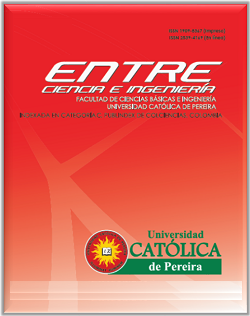Application of the design for manufacturing and assembly method to the chassis of a recumbent three-wheel human-powered vehicle as alternative transportation in the city of Montería
DOI:
https://doi.org/10.31908/19098367.4012Keywords:
Design for manufacturing and assembly, Transport, chassis, finite element analysis.Abstract
This work presents the design of the chassis of a human powered vehicle (HPV) type recumbent of three wheels through design studies based on finite element analysis provided by Solidworks® tool. The methodology of design for manufacturing and assembly (DFMA) promoted by Bootrhoyd was implemented, for which, the design of a model built in 2014 by mechanical engineering students called VTHR-1 was used as a comparison element to determine the effects produced by this methodology in the redesign of the chassis. As a result, a safety factor of 1,6 and an estimated life of 4,293x10^5 cycles, in addition, a decrease of 69% in the complexity of the assembly of the power transmission system was estimated, a 32% reduction in manufacturing cost and a structure 19% lighter, which translates into an indispensable method when it comes to directing the project as an alternative transportation mean in the city of Monteria.
References
Horwitz, R. M., “The Recumbent Trike Design Primer,” 2010.
Barbosa, G. F., and Carvalho, J. Design for manufacturing and assembly methodology applied to aircrafts design and manufacturing, vol. 46, no. 7. IFAC, 2013.
Boothroyd, G., Dewhurst, P., and Knight, W. A., Product Design for Manufacture and Assembly, III., no. 1. New York: Taylor & Frnacis Group, 2010.
Kamrani, A. K., and Salhieh, S. M. Product Design for Modularity, II., no. 1. 2002.
Molloy, O. and Tilley, S. Design for Manufacturing and Assembly, I., vol. 1. Chapman & Hall, 1998.
Iacob, R., Popescu, D., and Mitrouchev, P. “Assembly/Disassembly Analysis and Modeling Techniques: A Review,” Strojniški Vestn. – J. Mech. Eng., vol. 58, no. 11, pp. 653–664, 2012.
Gulati, E. V., Mehta, E. S., Mehtax, A., and Pawar, K. “Design and FEA of a Recumbent Trike,” vol. 7, no. 11, 2012.
Velomo, “Hi-Trike π - Velomo,” 2014.
Catrike, “Catrike 700,” 2014. [Online]. Available: http://www.catrike.com/#!700/c1dnt.
Buitrago, E. “Diseño del sistema de suspensión de un vehículo monoplaza tipo fórmula SENA,” Universidad Nacional de Colombia Sede Medellin, 2011.
ASME, “2014 Human powered vehicle challenge,” 2014.
Corporación Fondo de Prevención Vial, “Guía de CicloInfraestructura Ejemplos ilustrados y soluciones,” 2013.
Jensen, G. M. “Biomechanics of the lumbar intervertebral disk: a review.,” Phys. Ther., vol. 60, no. 6, pp. 765–773, 1980.
Baran, C., Mitchell, G. C., and Hellstrom, J. G., “Cycling-Related Sexual Dysfunction in Men and Women: A Review,” Sex. Med. Rev., vol. 2, pp. 93–101, 2014.
Leibovitch, I. and Mor, Y. “The vicious cycling: Bicycling related urogenital disorders,” Eur. Urol., vol. 47, pp. 277–286, 2005.
Sommer, F., Goldstein, I., and Korda, J. B., “Bicycle Riding and Erectile Dysfunction: A Review,” J. Sex. Med., vol. 7, pp. 2346–2358, 2010.
Jazar, R. N. Vehicle dynamics: Theory and Application, vol. 2. 2014.
Heisler, H. “Suspension,” in Advanced Vehicle Technology, 2002, pp. 368–449.
Consorcio Metalúrgico Nacional, “Perfil Estructural Tubular Negro y Galvanizado ASTM A500 (NTC 4526),” 2010.
Akshay Harlalka,C. D. Naiju,Mukund Nilakantan Janardhanan &Izabela Nielsen, "Redesign of an in-market food processor for manufacturing cost reduction using DFMA methodology" Production & Manufacturing Research Vol. 4, no. 1, pp.209-227, noviembre 2016 https://doi.org/10.1080/21693277.2016.1261052.








 Revista Entre Ciencia e Ingeniería
Revista Entre Ciencia e Ingeniería .png) entrecei@ucp.edu.co
entrecei@ucp.edu.co.png) ISSN (Impreso) 1909-8367 - ISSN (En Línea) 2539-4169
ISSN (Impreso) 1909-8367 - ISSN (En Línea) 2539-4169 Attribution-NonCommercial 4.0 International (CC By-NC 4.0)
Attribution-NonCommercial 4.0 International (CC By-NC 4.0)
.png) Carrera 21 No. 49-95 Av. de las Américas, Pereira, Risaralda, Colombia
Carrera 21 No. 49-95 Av. de las Américas, Pereira, Risaralda, Colombia